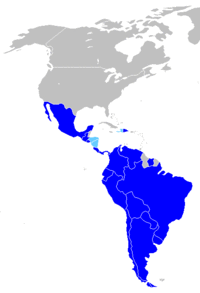Inter-American Convention to Prevent and Punish Torture
| Inter-American Convention to Prevent and Punish Torture | |
|---|---|
|
Ratified the convention
Signed, but has not ratified the convention | |
| Signed | 9 December 1985 |
| Location | Cartagena de Indias, Colombia |
| Effective | 28 February 1987 |
| Condition | 2 ratifications |
| Signatories | 20 |
| Parties | 18 |
| Depositary | General Secretariat of the Organization of American States |
| Languages | English, French, Portuguese, and Spanish |
The Inter-American Convention to Prevent and Punish Torture (IACPPT) is an international human rights instrument, created in 1985 within the Western Hemisphere Organization of American States and intended to prevent torture and other similar activities.
The Inter-American Convention entered into force on February 28, 1987, and, as of 2013, 18 nations are party to it, with another two having signed but not yet ratified.[1]
The Inter-American Convention defines torture more expansively than the United Nations Convention Against Torture, including "the use of methods upon a person intended to obliterate the personality of the victim or to diminish his physical or mental capacities, even if they do not cause physical pain or mental anguish." The Convention is one of a series of OAS agreements that seek to protect human rights, within the framework of the American Convention on Human Rights, which bans torture in less detail.
The Convention also requires states to take effective measures to prevent torture within their borders, and creates an ability to extradite persons accused of torture.
See also
- Command responsibility
- Inter-American Commission on Human Rights
- International human rights law
- Torture
- Torture by proxy
- Use of torture since 1948
